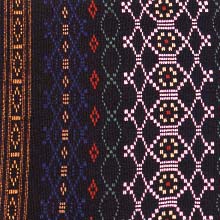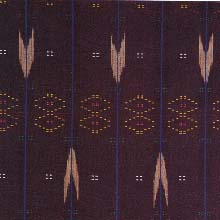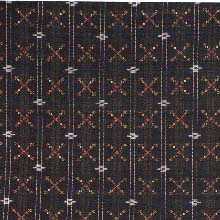Weave (p. 136 )
1. Produced in Yomitanson Nakagamigun, Okinawa Prefecture.
2. Characteristics: Fabric with raised designs of flower or geometrical patterns in which 5 pre-dyed threads are used. Color is restricted to 5: dark blue, white, red, yellow and green. 2 kinds of techniques are used to produce figure designs: (1) "Tibana(hand flower) Ori(weave)" or "Nuitori(embroidery) Ori," a technique to weave in the colored threads only in the design, (2) "Hiyai(heddles) Bana(flower) Ori," a technique to produce a raised design using heddles. Designs are 30 and more kinds of geometrical patterns based on 3 flowers: "Jinbana," "Ojibana" and "Kajimaya" ("Kazaguruma," Clematis patens). Other designs are combinations of the above with splash patterns, stripes and checks. Fabrics are mostly cotton but occasionally mixed with "Basho," hemp or silk. They are all dyed with plant dyes.
3. Uses: Clothing, "Minsa"(undersash), handkerchiefs.
4. History: It is presumed that the fabric was originated in and transmitted from Southeastern countries such as Thailand, Myanmar(Burma) and Java(Indonesia). About 550 years ago, the fabric was designated by the Ryukyu Dynasty as specific cloth which aristocrats in Shuri (the capital of Ryukyu then) and the people in Yomitan only could use. Although prohibited for use by other people, it had been woven until the Meiji Period. But production ceased in the late Meiji to Showa Periods. It was revived in 1964 under the guidance of the village office and has been popular as a traditional handicraft.





